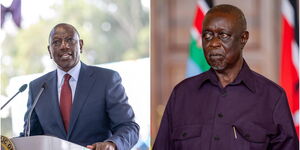The Kenyan Shilling has maintained its stability against the US dollar, holding firm even as the dollar reached a two-month high on Tuesday.
Despite the greenbuck's upward momentum, data from the London Stock Exchange Group (LSG) showed that the Shilling remained unchanged from Friday's level, trading at Ksh128.50/Ksh129.50 per dollar.
The Central Bank of Kenya (CBK) reported a slight gain in the shilling’s value, with rates inching up from Ksh129.1955 on Monday to Ksh129.1965 on Tuesday. This marginal rise points to the currency's resilience amid persistent global financial pressures, especially with the dollar showing strength due to investor sentiment.
On the global front, the US dollar's strength was partly driven by market speculation that the Federal Reserve would not reduce interest rates as aggressively as previously anticipated. With the dollar holding near its peak, some analysts pointed to growing optimism for a potential victory for former President Donald Trump in the upcoming election, further adding to market volatility.
At home, the CBK’s strategic interventions in the forex market have played a crucial role in stabilising the shilling, curbing any sharp swings that could unsettle the economy. The shilling's resilience has been buoyed by inflows from the tourism sector and agricultural exports like tea, which have cushioned the currency against the adverse effects of political unrest and a delayed International Monetary Fund loan.
The shilling's stability also comes on the back of government measures earlier in the year, including a $1.5 billion Eurobond that was issued to calm markets by repurchasing a substantial portion of a maturing $2 billion bond. The move soothed concerns among investors who had been rattled by fears of Kenya defaulting on its dollar-denominated debt.
The recent stability of the shilling has brought welcome relief to Kenyan households, as a stronger currency has helped ease inflationary pressures. September saw a drop in year-on-year inflation to 3.6 per cent from 4.4 per cent in August, thanks in part to the reduced cost of imported goods. Month-on-month inflation held steady at 0.2 per cent, reflecting the impact of a firmer shilling on consumer prices.
Fuel prices also declined, with the Energy and Petroleum Regulatory Authority announcing price cuts for Super Petrol, Diesel, and Kerosene from October 15, providing a further break for consumers. The cheaper fuel is expected to lower transport and production costs across various sectors, aiding in the broader effort to keep inflation in check.
The currency's stability has restored some investor confidence, particularly in the capital markets, which had been shaken by earlier currency depreciation and dividend repatriation challenges. As foreign investors eye opportunities in Kenya’s agriculture and tourism sectors, the stronger shilling is proving to be a catalyst for renewed interest.
While private equity and venture capital flows have been slowing across Africa, Kenya's steady currency positions the country as an attractive destination for foreign investment. The reduction in currency-related risks may spark renewed confidence in sectors offering stable returns, paving the way for continued economic growth.
Maintaining this momentum will be crucial as Kenya navigates global economic headwinds, with currency stability emerging as a key pillar in safeguarding the country’s economic gains.












